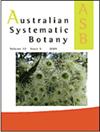形态学和分子数据显示,原被异型种概念所掩盖的梧桐(Phyllanthaceae, Phyllantheae)具有扩大的热带澳大利亚辐射
IF 1.6
3区 生物学
Q4 EVOLUTIONARY BIOLOGY
引用次数: 2
摘要
叶爪龙(F.Muell)Benth交货)。艾里·肖和S. rigidulus (F.Muell)Mull.Arg交货)。艾里·肖属被修订为恢复属。(Phyllanthaceae),利用形态学和nrITS序列数据。J.T.Hunter & J.J.Bruhl和S. elachophyllus被证明是同种的,如Synostemon elachophyllus。Benth交货)。I.Telford & presapan and S. elachophyllus subsp。j.t hunter & J.J.Bruhl) I.Telford & Pruesapan,与松毛虫子(Synostemon elachophyllus subsp)在等级上提高的特尔福德和普雷斯帕安(同:长爪龙变种葛瑞尔·艾里·肖)。“顶端枝”具有融合的雄蕊花丝和连接物的形态突触,以及线状、纵向的花药。命名了4个新种:Synostemon cowiei I.Telford & J.J.Bruhl, S. inaequisepalus I.Telford & J.J.Bruhl, S. kakadu I.Telford & J.J.Bruhl和S. nitmiluk I.Telford & J.J.Bruhl,并提供了新的组合:S. crassifolius (m本文章由计算机程序翻译,如有差异,请以英文原文为准。
Morphological and molecular data show an enlarged tropical Australian radiation in Synostemon (Phyllanthaceae, Phyllantheae) previously concealed by heteromorphic species concepts
Sauropus elachophyllus (F.Muell. ex Benth.) Airy Shaw and S. rigidulus (F.Muell. ex Müll.Arg.) Airy Shaw are revised under the reinstated genus Synostemon F.Muell. (Phyllanthaceae) using morphological and nrITS sequence data. Sauropus decrescentifolius J.T.Hunter & J.J.Bruhl and S. elachophyllus are shown to be conspecific as Synostemon elachophyllus (F.Muell. ex Benth.) I.Telford & Pruesapan and S. elachophyllus subsp. decrescentifolius (J.T.Hunter & J.J.Bruhl) I.Telford & Pruesapan, with Synostemon elachophyllus subsp. latior (Airy Shaw) I.Telford & Pruesapan (syn. Sauropus elachophyllus var. glaber Airy Shaw p.p.) raised in rank. The ‘Top End clade’ has morphological synapomorphies of fused staminal filaments and connectives, and linear, longitudinal anthers. Four new species are named: Synostemon cowiei I.Telford & J.J.Bruhl, S. inaequisepalus I.Telford & J.J.Bruhl, S. kakadu I.Telford & J.J.Bruhl and S. nitmiluk I.Telford & J.J.Bruhl and new combinations are provided: S. crassifolius (Müll.Arg.) I.Telford & Pruesapan, S. ditassoides (Müll.Arg.) I.Telford & Pruesapan, S. dunlopii (J.T.Hunter & J.J.Bruhl) I.Telford & Pruesapan, S. filicinus (J.T.Hunter & J.J.Bruhl) I.Telford & Pruesapan, S. gracilis (J.T.Hunter & J.J.Bruhl) I.Telford & Pruesapan, S. rigidulus (F.Muell. ex Müll.Arg.) I.Telford & Pruesapan, and S. stenocladus (S.Moore) I.Telford & Pruesapan, with S. pinifolius (J.T.Hunter & J.J.Bruhl) I.Telford & Pruesapan also raised in rank.
求助全文
通过发布文献求助,成功后即可免费获取论文全文。
去求助
来源期刊

Australian Systematic Botany
生物-进化生物学
CiteScore
3.10
自引率
12.50%
发文量
12
审稿时长
>12 weeks
期刊介绍:
Australian Systematic Botany is an international journal devoted to the systematics, taxonomy, and related aspects of biogeography and evolution of all algae, fungi and plants, including fossils. Descriptive taxonomic papers should normally constitute a comprehensive treatment of a group. Short papers on individual species and nomenclatural papers must contain significant new information of broader interest to be considered. The prestigious L.A.S. Johnson Review Series is published. Other review articles will also be considered. All papers are peer reviewed.
Australian Systematic Botany is published with the endorsement of the Commonwealth Scientific and Industrial Research Organisation (CSIRO) and the Australian Academy of Science.
 求助内容:
求助内容: 应助结果提醒方式:
应助结果提醒方式:


